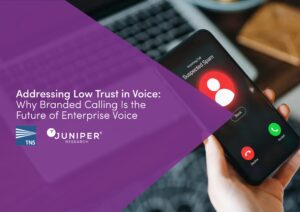TNS recently released its 2024 Robocall Investigation Report. The industry report captures changes in robocall volume, carrier progress with STIR/SHAKEN attestation and call signing and regulatory action. In addition, the report features information on the latest technological innovation designed to mitigate unwanted calls, as well as revealing the latest high-impact scams.
Overall, the data shows how advancements in call signing are improving the outlook for consumers, with noted increases in authenticated traffic. The full report goes beyond the headlining statistics and delves into the rise in sophisticated robocall scams and the impact of robocall protection solutions. As a preview of the full findings, we’ve shared some of the key questions and answers from the report below:
What is the overall state of robocalls in 2024?
STIR/SHAKEN continues to pay dividends. The Report shows the top seven US carriers (Verizon, UScellular, T-Mobile, Lumen, Comcast, Charter and AT&T) continue to make strides on multiple fronts when it comes to protecting subscribers from unwanted robocalls. Unwanted robocall volume from Tier-1 carriers decreased year-over-year and 85% of calls between those top operators were signed, up from 76% in 2022.
Smaller carriers have improved their signed traffic overall (21% of calls were signed in 2023, up from 15% in 2022), but a wide gap persists in total signed traffic from Tier-1 carriers.
Where do the majority of robocalls come from?
Despite increased SIP interconnectivity and improved signed traffic by smaller carriers, several line types remain vulnerable, including toll-free numbers and VoIP lines. While toll-free traffic is still the top generator of unwanted calls, VoIP networks remain responsible for the highest percentage of unwanted calls to consumers, with little improvement since 2022.
What progress has been made in reducing robocalls, and what role does call signing play in that effort?
We’ve seen significant progress in mitigating the influx of robocalls Americans receive thanks largely to STIR/SHAKEN implementation and improved call-signing practices. TNS’ Robocall Report finds that over 80% of traffic between Tier-1 carriers is now signed with Attestation “A”.
Unfortunately, small carriers generally lag behind this standard, with barely 20% of terminating traffic from small carriers being signed. To protect subscribers regardless of carrier size, smaller carriers must expand their SIP interconnectivity to keep pace with Tier-1 carriers’ call authentication and robocall mitigation efforts. For those operators, TNS TDM Link Replacement can serve as a digital transformation path that converts signaling protocols to meet STIR/SHAKEN requirements.
How has STIR/SHAKEN played a role in reducing robocalls?
By enforcing a standard for call signing, the STIR/SHAKEN mandate has led to a more than 8% improvement in signing over the past year across the board. With a digital signature on each call verifying the caller’s ID, carriers can flag or block calls that lack a verified signature, reducing the reach of fraudulent robocalls to consumers.
What are some notable robocall scams from 2023 people should be aware of?
Older scams like package and mail delivery and the Can You Hear Me? schemes remained prevalent in 2023, however, the increased capability and accessibility of generative AI tools in 2023 led to a rise in AI voice cloning scams.
One AI voice cloning scam that emerged in 2023 involved bad actors using AI to mimic the voices of family members or acquaintances and suggesting they were injured or kidnapped and in need of money. To safeguard against such scams, it’s crucial to verify the caller’s identity through a separate communication channel and be wary of any call that asks for immediate financial action or personal information, regardless of how familiar the voice may sound.
To fight the robocall bad actors that have quickly operationalized and deployed generative AI to spread chaos, TNS launched AI Labs to research and develop new AI solutions – including voice biometrics, predictive call analytics, generative AI and AI SMS detection.
For a deeper dive into the outlook for robocalls in 2024, request a copy of the TNS 2024 Robocall Investigation Report here.
John Haraburda is Product Lead for TNS Call Guardian® with specific responsibility for TNS’ Communications Market solutions.
Download TNS’ Robocall Investigation Report
Gain exclusive insights into robocall trends and tactics, with line type data comparisons guiding your strategy in 2024.




